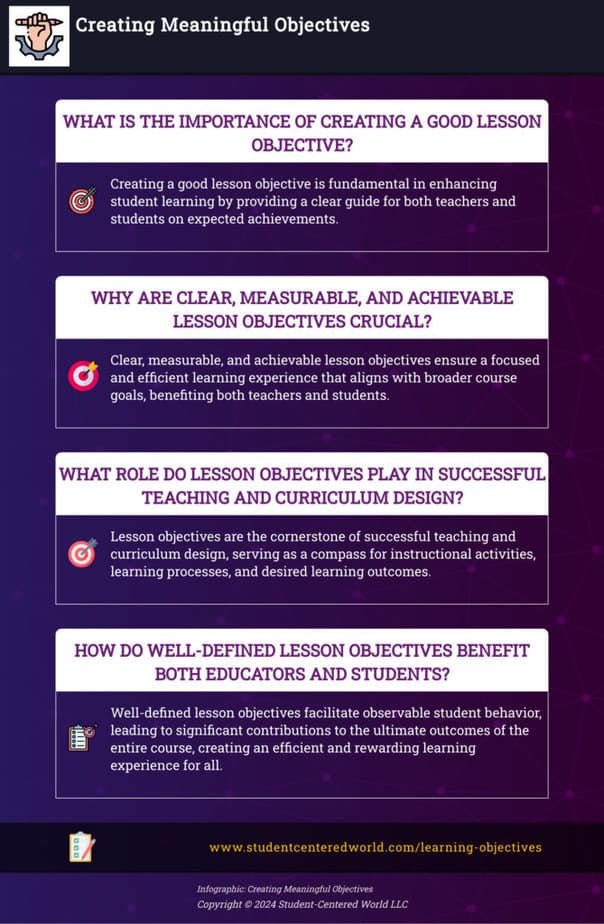Writing Learning Objectives for Effective Outcomes
Creating a good lesson objective may seem like a daunting task to many educators. However, it’s a fundamental step in the course design process that can significantly enhance student learning. Effective learning objectives serve as a clear guide for both teachers and students, outlining what learners are expected to achieve by the end of a lesson or course.
Creating meaningful and effective lesson objectives is a cornerstone of successful teaching and curriculum design. Far from being a tedious task, the formulation of clear, measurable, and achievable lesson objectives is crucial for both teachers and students. It ensures a focused and efficient learning experience that aligns with the broader course goals.
This comprehensive guide aims to demystify the process, illustrating why well-crafted lesson objectives are not only a good idea but essential for the educational journey. Let’s explore a variety of concepts, including the cognitive, affective, and psychomotor domains, levels of learning, and the use of concrete actions to define measurable behaviors.
Educators should have a clear picture of how to create lesson objectives that facilitate observable student behavior and contribute significantly to the ultimate outcomes of the entire course.
The Foundation of Effective Lesson Planning
At the heart of every successful lesson plan lies a well-defined objective. These objectives serve as the compass for the lesson, guiding both instructional activities and learning processes. They provide a clear statement of what students are expected to learn by the end of the lesson, ensuring that the course materials and activities are aligned with the desired learning outcomes. By setting a clear direction, educators can design their lessons to meet specific course goals, making the learning experience both efficient and rewarding.
This clarity is fundamental not only for the educators, who gain a focused pathway to impart knowledge but also for the students, who benefit from a structured learning environment that communicates expectations and outcomes.
Well-crafted objectives act as benchmarks for both teaching and learning, enabling the tracking of progress throughout the lesson and the course. They help in identifying specific knowledge gaps and in adjusting teaching methods to address these gaps effectively. Furthermore, explicit objectives support the development of assessment tools that are directly aligned with learning goals, facilitating more accurate and meaningful evaluations of student progress.
In essence, the meticulous crafting of lesson objectives underscores the importance of intentionality in education, ensuring that every lesson contributes purposefully towards broader educational aims.
Incorporating Domains of Learning
Benjamin Bloom’s Taxonomy of Educational Objectives offers a framework for categorizing educational goals into cognitive (knowledge-based), affective (emotion-based), and psychomotor (action-based) domains. Incorporating objectives from these domains ensures a holistic approach to learning, addressing the development of knowledge, attitudes, and skills.
- Cognitive Domain: Involves intellectual skills and comprehension. Objectives in this domain focus on the acquisition of new knowledge and cognitive processes, from recalling basic facts (lower level) to evaluating information and creating new ideas (higher level).
- Affective Domain: Pertains to emotions, attitudes, and values. Objectives here aim to influence students’ feelings or emotional responses, encouraging values like respect, appreciation, and motivation.
- Psychomotor Domain: Concerns about physical skills and actions. These objectives are centered around the development of manual or physical skills, from basic movements to complex actions requiring precise coordination.
Setting Measurable Learning Objectives
A key aspect of effective lesson planning is the ability to set measurable learning objectives. This involves using concrete action verbs that specify observable student behavior, allowing for the assessment of whether the objectives have been achieved. Verb tables, based on Bloom’s taxonomy, offer a variety of examples of action verbs that can be used to articulate clear, measurable objectives for different levels of learning, such as “describe,” “analyze,” “construct,” and “evaluate.”
Structuring Objectives for Different Levels of Learning
Objectives should be structured to address the specific levels of learning desired by the end of the course. Course level objectives outline the broad goals for the entire course, focusing on the development of core concepts and overarching skills. In contrast, lesson-level objectives are more specific, detailing the concrete actions and measurable behaviors students should demonstrate by the end of a lesson. This differentiation ensures that each lesson contributes effectively to the achievement of the course’s ultimate outcomes.
Utilizing Resources and Additional Materials
The development of effective lesson objectives often requires the utilization of available resources and additional materials. This can include instructional materials, evidence-based teaching guides, and online courses that offer insights into effective ways to achieve learning outcomes.
These resources can also offer additional support for professional development, helping educators refine their skills in crafting clear and achievable objectives.

Concrete Examples and Clear Statements
Effective lesson objectives are characterized by their specificity and clarity. A well-written objective typically follows a single sentence structure that includes a concrete action verb, the content or skill to be learned, and the criterion of acceptable performance.
For instance, a lesson objective in a business management course might state, “By the end of this lesson, students will be able to analyze case studies using scientific methods to identify core business management concepts.”
Evaluation and Assessment
A crucial part of the lesson plan is the evaluation and assessment of whether the lesson objectives have been met. This involves designing quiz questions, course activities, and group work that align with the lesson’s objectives, allowing for the direct observation of students’ abilities to perform the specified actions.
The criterion of acceptable performance should be clear from the outset, with a clear deadline for when the objectives should be met.
Starting Points and Ultimate Outcomes
The formulation of lesson objectives should always begin with the end in mind. By considering the ultimate outcomes desired at the end of the course, educators can work backward to identify the specific steps and objectives needed to achieve these goals.
This backward design approach ensures that each lesson builds upon the previous one, gradually leading students toward the achievement of the course’s overarching objectives.
Engaging in Research and Professional Development
Keeping abreast of the latest research findings and engaging in continuous professional development are important conditions for creating effective lesson objectives. Anderson & Krathwohl’s revision of Bloom’s taxonomy and the integration of scientific methods into lesson planning are examples of how educators can incorporate research-based strategies into their teaching. Additionally, professional development opportunities can offer insights into new and effective ways of achieving learning outcomes, further enhancing the educational experience.
Crafting meaningful and measurable lesson objectives is a foundational aspect of effective teaching and course design. By setting clear, achievable goals that encompass the cognitive, affective, and psychomotor domains, educators can provide students with a structured and engaging learning experience. The use of concrete actions, specific statements, and measurable behaviors, guided by evidence-based teaching guides and additional resources, ensures that lesson objectives are both meaningful and assessable.
Ultimately, well-crafted lesson objectives not only clarify the purpose and direction of individual lessons but also contribute to the achievement of the broader goals of the course, leading to a more impactful and rewarding educational journey for both teachers and students.
Step 1: Understand the Domains of Learning
Before diving into writing objectives, it’s crucial to understand the three domains of learning identified by Benjamin Bloom’s Taxonomy: cognitive (mental skills or knowledge), affective (growth in feelings or emotional areas), and psychomotor (manual or physical skills). Lesson objectives can target one or more of these domains, depending on the course content and the desired learning outcomes.
Step 2: Identify the Desired Learning Outcomes
The first step in crafting effective lesson objectives is to clearly define the learning outcomes you aim to achieve by the end of the course. These outcomes should be aligned with the broader goals of the course and the school-year objectives. Consider what specific knowledge, skills, or attitudes students should develop as a result of instruction.
Step 3: Choose the Right Level of Cognitive Domain
Utilize Benjamin Bloom’s Taxonomy to select the appropriate level of cognitive domain for your objectives. This taxonomy ranges from lower-level cognitive skills, like remembering and understanding, to higher-level thinking skills, such as analyzing, evaluating, and creating. Your lesson objectives should reflect the complexity of the cognitive processes you want your students to engage in.
Step 4: Write Measurable Objectives
Good learning objectives are measurable and observable. They describe the desired outcome in terms of observable behavior or measurable results. Use a measurable verb to start each objective, ensuring that the result of instruction can be assessed. For instance, verbs like “identify,” “compare,” “construct,” or “analyze” are effective choices that make it clear what students need to do.
Step 5: Ensure Objectives are SMART
SMART learning objectives are Specific, Measurable, Achievable, Relevant, and Time-bound. This framework ensures that objectives are not only clear and concrete but also realistic and directly related to the learning goals. A well-written objective might read, “By the end of this lesson, students will be able to calculate the area of triangles using the formula, with 95% accuracy on a quiz.”
Step 6: Align Objectives with Instructional Activities and Assessments
Each objective should have corresponding instructional activities and assessments. This alignment ensures that the learning activities support students in achieving the objectives, and the assessments accurately measure whether the objectives have been met. Consider different ways of learning and assessing, such as group work, individual projects, or quizzes, to cater to diverse learning needs.
Step 7: Communicate Objectives Clearly to Students
A key takeaway for instructional designers and teachers is the importance of clearly communicating the lesson objectives to students at the start of the lesson. This gives students a clear picture of what is expected of them and how they can achieve the lesson level objectives.
Conclusion
Crafting effective learning objectives is an important condition for the success of any educational experience. By following these steps, teachers can create meaningful objectives that are easy to monitor and assess. This not only simplifies the teaching and learning process but also enhances the overall learning experience by providing a clear direction and end goal.
Remember, the ultimate outcome of well-structured course objectives is not just the achievement of specific objectives but the promotion of deeper understanding and the development of critical thinking skills among students.
Incorporating these practices into your lesson planning will not only make the process less tedious but also more impactful. By focusing on creating SMART objectives that align with the cognitive, affective, and psychomotor domains, you will foster an environment where students can achieve meaningful learning outcomes and apply new knowledge and skills in various contexts. This approach enhances engagement, encourages critical thinking, and prepares students for real-world challenges, ensuring that education transcends the classroom and becomes a valuable tool for lifelong success.
Stop Driving the Teacher Struggle Bus
Are you struggling with student engagement, apathy, or keeping your class on track?
💫💫 There’s hope! 💫💫
Join my free teacher workshop “Choosing Choice” and in just 45 minutes, you’ll craft a practical plan to revitalize your teaching. Discover the magic of student choice in boosting engagement, gain quick implementation ideas, and explore strategies for year-long success.
Unlike overwhelming workshops, my approach guides you in real-time, providing more classroom options, reducing stress, and giving you more personal time.
Plus, you’ll earn a 45-minute professional development certificate and have 7 days of access.
Don’t miss this chance to transform your teaching; click below to secure your spot now!







